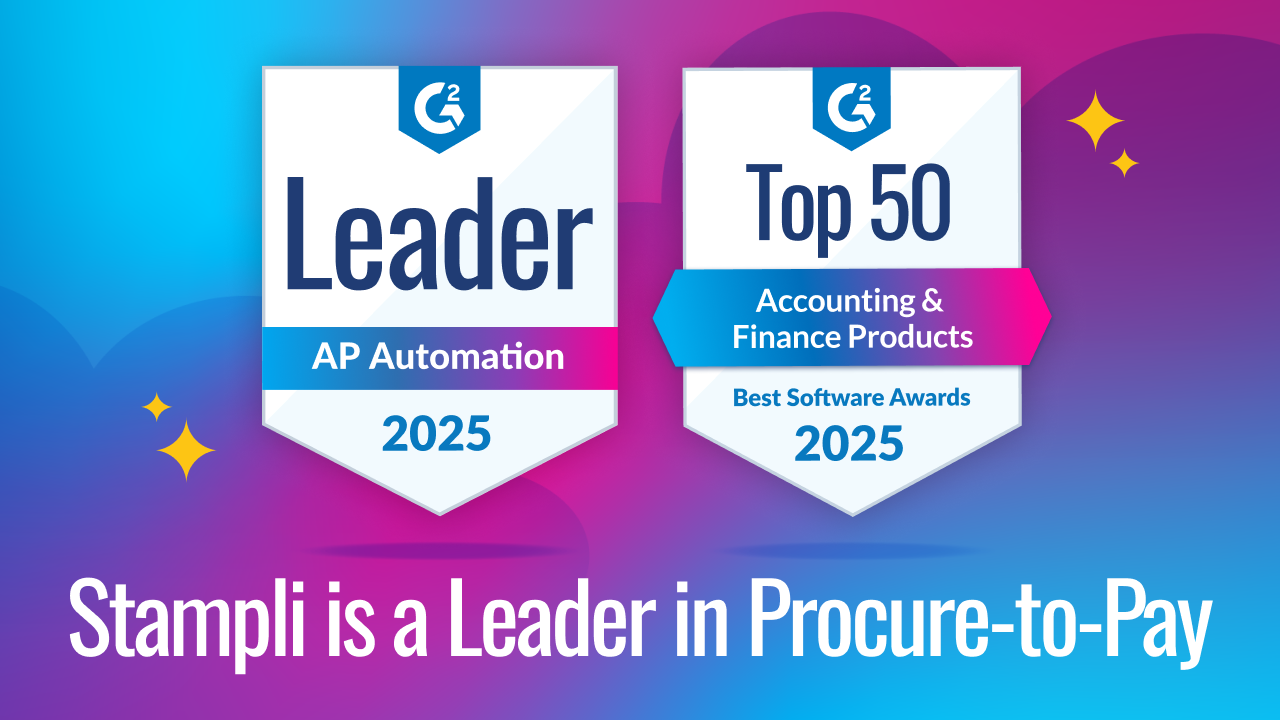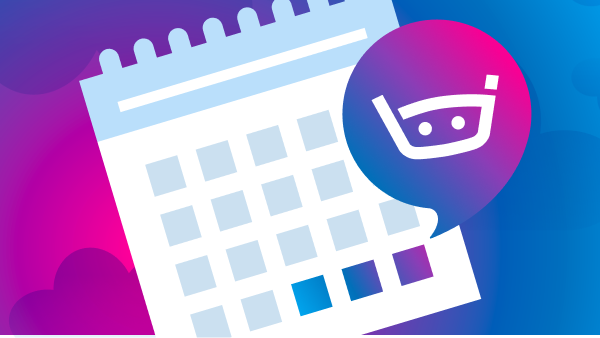Microsoft Great Plains end-of-life: How to plan for business continuity

In April 2023, Microsoft announced that Dynamics Great Plains (Dynamics GP) sales will end in 2026.
The change has left many longtime GP users wondering what to do. Microsoft will support GP until 2028, so it will be around for a while. However, CFOs should also consider the impact of relying on software that won’t be evolving beyond bug fixes. Migrating from GP to another ERP can be challenging, especially if you’ve used the software for a long time. But staying on GP without a continuity plan could be just as risky.
In this article, we’ll help you build a strategy to maintain business continuity as Microsoft winds down GP. We’ll help you understand how the GP sunset might affect your business and explore the pros and cons of staying with GP or migrating to a new ERP platform. We’ll also show you how Stampli’s no code pre-built ERP integrations help you streamline AP for GP, and other ERPs if that’s your path, all the while without the need to rework your ERP.
Let’s dive in.
What’s happening with Dynamics GP?
Here are the details of Microsoft’s announcement:
- New sales of GP perpetual licenses will end on April 1, 2025. New customers can still purchase GP subscription licenses.
- All new customer sales of GP will end on April 1, 2026. Existing customers may still purchase licenses and modules.
- Microsoft will provide tax updates, security updates, and hotfixes three times a year until at least 2028.
- Customer support will be provided under the Microsoft Modern Lifecycle policy until at least 2028.
In a nutshell, GP isn’t going away, but Microsoft isn’t developing any new product features or enhancements. They’ll continue supporting GP customers and will release regularly scheduled updates including feature, tax, and regulatory updates and hotfixes.
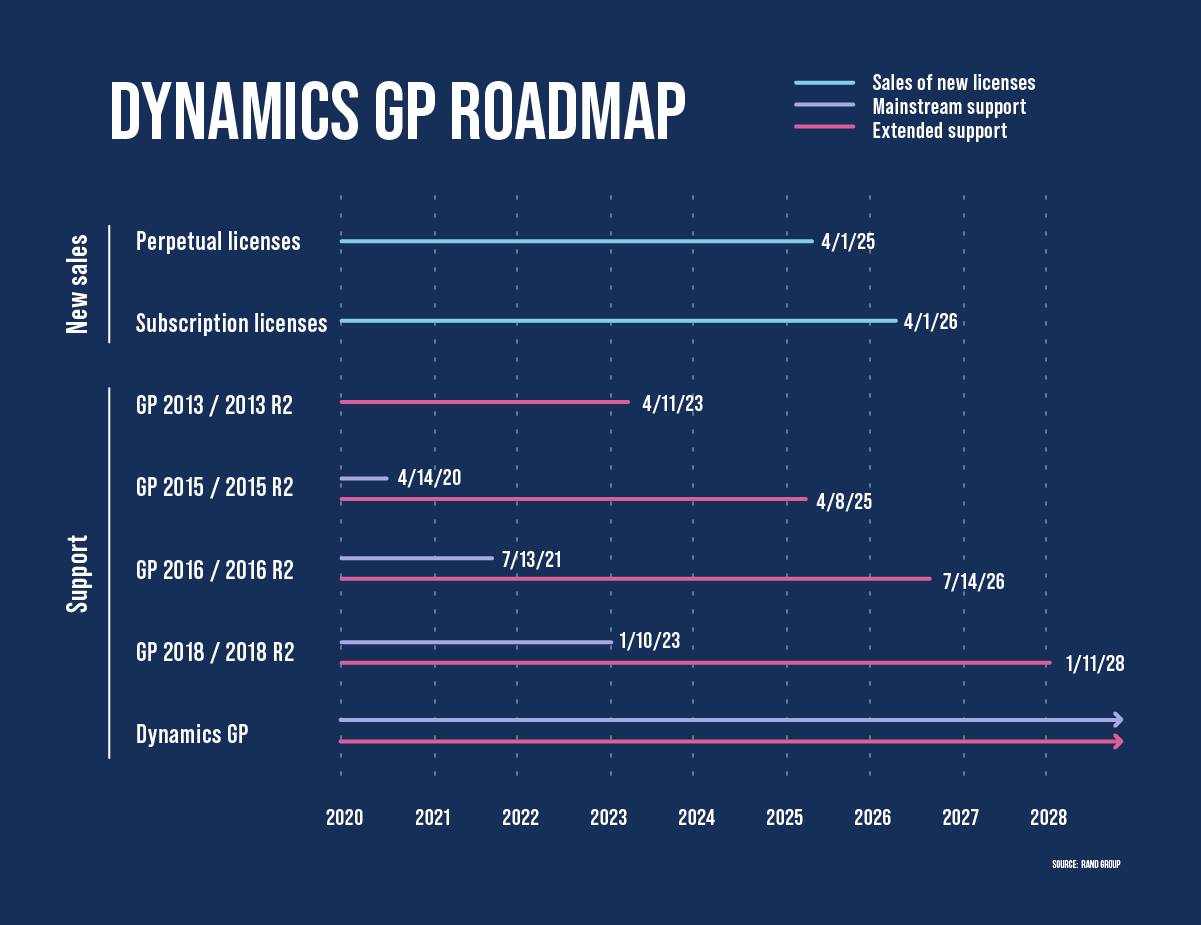
What about older versions of GP?
Microsoft will continue to provide support for older (Pre-2019) versions of Dynamics GP under their Fixed Lifecycle support policy. Fixed Lifecycle offers a three-phase support model:
- Mainstream support: Offered for five years after the product release date.
- Extended support: Offered for five years after Mainstream support expires. During Extended support, Microsoft only releases updates for security vulnerabilities. It doesn’t fix bugs unless they cause a security issue.
- End of life: Microsoft no longer updates the product, and users won’t be able to open support tickets.
All Pre-2019 versions of GP are under Extended support and will reach their end of life by January 11, 2028.
How could the GP sunset affect your business?
In the short term, the GP sunset may not have a major impact on your business. Microsoft will continue to provide bug fixes and updates so the software will still work.
However, in the long run, some factors could affect your business continuity.
No new product development or features
In its announcement, Microsoft said it was focusing its resources on cloud-based products like 365 Business Central and encouraging customers to move from legacy on-premises solutions like GP to cloud-based services.
Financial automation technologies are evolving to become more powerful and flexible. Although GP remains a stable and powerful solution for now, without innovation it will gradually fall behind the competition.
While we’re not suggesting you rush into new technologies, you should take the opportunity to explore your options for automating financial processes.
GP customer support will eventually end
Microsoft has announced it will continue to support Dynamics GP until at least 2028. However, support for the system will eventually end. You should weigh the value of investing in ongoing training and IT work for GP against investing in the same for a new platform.
Other Microsoft products may not continue to support GP integration
There is no guarantee that other Microsoft products, such as Office 365, will continue to support full integration with GP through 2028 and beyond. If Microsoft ends integration support for a product you use, you may need to invest in IT work to find a workaround or alternative solution.
Microsoft may not support GP modules in the future
In March 2022, Microsoft announced that it was discontinuing the Extended Human Resources and Payroll modules in GP and transitioning them to a third-party provider. If Microsoft discontinues other GP modules in the future, you may be forced to find a new solution or switch to a different ERP.
Third-party add-on providers may end GP support
On November 29, 2023, BILL (formerly bill.com) announced that effective December 1, 2023, it would no longer support integration with Microsoft Great Plains (Dynamics GP).
Other third-party integration providers may follow BILL’s lead and end support for their GP solutions. In that case, you may need to migrate the affected financial processes to a different add-on or AP automation platform.
How should your business move forward with Dynamics GP?
GP is a tried-and-tested platform used by thousands of companies as their core financial automation solution, even prior to Microsoft’s acquisition of Great Plains Software Inc. in 2001. Its main strength is that it provides business continuity. For most GP users, a GP end-of-life strategy must be founded on maintaining that continuity, regardless of what path they take.
With that in mind, it’s best to start your strategy by looking at your current and future business needs.
Evaluate your current and future needs
Start your GP end-of-life strategy by looking at your current and future business needs. Here are some factors to consider:
- What does your company like/dislike about GP? What do users like? What do they complain about?
- Which financial processes are you currently automating with GP, and how well is that working? What processes would you improve if you could?
- What processes are you performing manually? If possible, would you automate these processes without disrupting your business?
- What GP modules and add-ons are you currently using? What workaround solutions are you using for functions like vendor payment processing?
- Do you have a fall-back plan if support for these modules or add-ons is discontinued?
- What is your business growth forecast for the next 3-5 years? What financial processes would you need to scale up or adapt to support that growth?
- Do you have a process to update GP when your business workflows change? How much does this process cost in terms of time and resources?
- Have you forecasted the costs of staying with GP when it is no longer supported by Microsoft?
With these factors in mind, you can look at your options with a clear idea of where to start.
End-of-life options for Microsoft GP
Fortunately, you’ve got several paths to consider in your GP end-of-life strategy. We can broadly group them under two strategies:
- Stay on GP for as long as possible.
- Move GP to the cloud with a 3rd party consultant.
- Migrate to another financial automation system or ERP.
As we’ll see, your ideal path may include a combination of both strategies. For example, you may choose to stay on GP, but migrate some financial processes like payroll or accounts payable to an integrated solution.
Let’s look at your options.
Option 1: Stay on Dynamics GP
Many companies may opt to stay with GP in the medium or long term. GP is a solid ERP that has served well for decades, and staying on the platform is a viable option for businesses that don’t have the capital to make the transition.
If you decide to remain on GP, there are a few steps you can take to optimize its performance and minimize risks to your business.
Upgrade to the latest version
If you are currently using a pre-2019 version of GP, consider upgrading to the latest version. Upgrading ensures that you will continue to receive support and software updates under Microsoft’s Modern Lifecycle policy.
If you are using the current version of GP, you will receive continuous support until at least 2028. Note that you must remain current under the Modern Lifecycle policy to remain eligible for continued support. To remain current, apply one of the three annual updates.
Determine vulnerable modules and add-ons
Check to see which GP modules and add-ons your company is currently using. Sort them by importance, being careful to identify the ones that are critical to your financial operations. Doing this will help you assess where you may be vulnerable if a module or add-on is discontinued. It will also help you decide which modules and add-ons you can migrate to another solution in the future if needed.
If you need assistance finding which add-ons your company uses, Stampli can help. We’ve developed a solution that identifies GP add-ons.
Confirm third-party integrations support GP
As mentioned earlier, some third-party accounting solution providers may follow in the footsteps of BILL and discontinue their support for Dynamics GP integrations. After you’ve identified the add-ons your company is using, confirm with the providers how long they plan to continue GP support. If they are unwilling or unable to answer, flag those add-ons as potentially at risk.
Consider moving mission-critical modules or add-ons to another solution
Your business may be at risk if Microsoft or a third-party provider discontinues support for a GP module or add-on it relies on. Go through your list of mission-critical and at-risk modules and add-ons and develop a plan to migrate these to an alternative solution.
Stampli: The only AP solution provider that supports full GP functionality
If you’re looking for an alternative to Dynamics Great Plains for accounts payable, or if you’re concerned your current AP provider won’t support GP integration, look to Stampli. Built by AP experts for AP experts, Stampli is the only AP automation solution that builds its own ERP integrations from scratch, and it supports GP’s full native functionality.
Other AP automation platforms don’t support GP’s full functionality. Only Stampli provides a seamless AP automation solution that can be implemented with no change to your GP workflows. Here’s how Stampli can help you ensure business continuity with GP:
- Full support for GP functions: Stampli supports the full GP feature set without compromising critical functions or requiring IT rework.
- Real-time data sync: Stampli’s API integration ensures real-time sync for purchase orders and other business data.
- Committed to GP development: Stampli will develop its GP integration and support GP customers as long as the platform exists.
- On-premises integration: Stampli’s bridge integration installs on the same computer as eConnect to integrate with GP without slowdowns or connection issues.
- Add-on support: Stampli identifies what add-ons you are using, supports MEM, Job Cost, and Service Call add-ons, and can develop support for additional add-ons.
- Integrated payment support: Stampli Direct Pay integrates with GP to let you pay vendors without add-ons that slow down or lock your system.
- Continuity if you migrate ERPs: Stampli has supported many migrations and integrates with all major ERPs, including 365 Finance and Business Central, so your choices won’t be constrained if you leave GP.
Stampli will continue to develop its GP integration as long as the platform exists. With Stampli, you can modernize your accounts payable processing while maintaining complete continuity with your existing GP setup.
Customers say Stampli helps them save time and money by making AP processing smarter and faster. “The best aspect of Stampli is its seamless automation of the accounts payable process,” says one customer. “The intelligent invoice processing and approval workflows have significantly streamlined our operations, saving time and reducing manual errors… Stampli provides a transparent and traceable audit trail, allowing us to monitor the status of invoices at every stage. Disparate systems and manual data entry caused inconsistencies and inefficiencies in data management. Stampli’s integration capabilities with other systems help to create a more seamless and connected financial ecosystem.”
Learn more about how Stampli intends to support GP customers.
Whether you choose to do it now or later, at some point you will need to migrate from GP to another ERP or automation platform. Your analysis may reveal that although GP provides a stable foundation for your business today, the uncertainty around GP’s eventual sunset puts your business continuity at risk. Or, you may want to use the opportunity to move to a platform that offers greater flexibility and capabilities.
There are several options for migrating from the on-premise GP platform to a different solution. You can migrate your GP solution to a cloud-based platform, another Microsoft solution like Dynamics Business Central, or to another ERP like Sage Intacct or SAP.
Let’s take a closer look at the options.
Option 2: Host GP in the cloud
Host GP in the cloud
Microsoft offers the option to deploy GP on Azure as a cloud-hosted system. According to Microsoft, this brings numerous advantages over the on-premises GP solution.
- Scalability: Add processing capacity without buying new physical servers.
- Risk management: Store data in the Azure cloud rather than managing it onsite.
- Business continuity: Azure Backup automatically backs up and recovers your system data.
- Greater security: Automatic security measures ensure your business is protected.
- Remote access: Users can securely access GP from remote desktops.
Note that deploying GP on Azure doesn’t affect its eventual sunset. Your business will face many of the same challenges as it does with the on-premises GP platform.
Option 3: Migrate to another financial automation platform
Migrate to another Microsoft Dynamics platform
Dynamics GP customers who want to stay in the Microsoft ecosystem can consider migrating GP to Business Central (BC), or 365 Finance and Operations. These next-generation, cloud-based ERPs offer flexibility and functionality, ongoing support and product development, and integration with other Microsoft products and third-party integrations.
Microsoft provides a comprehensive migration guide, data migration guide, and feature comparison guide for customers considering migrating from GP to BC.
Although Dynamics is a flexible and powerful ERP, it may not be the best accounts payable solution for your business. Large ERPs like Dynamics BC and F&O feature complex organizational structures and strict user roles. Although these features are valuable from a high-level organizational standpoint, they can make it difficult for AP teams to access the information and people they need to process invoices efficiently.
One Dynamics BC customer describes the problem in detail: “[Dynamics BC] is an extremely cumbersome product with a clunky user interface. It’s not easy to navigate; the way to work through menus / field selectors / etc. is not always intuitive…Further, the database structure is horrendous. If you work with database tables, for reporting, etc. purposes, you’ll find every company you create (and we all know accountants love creating multiple companies) is in the one database, with its own set of tables…— you can seriously have 10s of thousands, if not hundreds of thousands of tables, in one database. Then all your data engineering pipelines time out when trying to do database discovery.”
Stampli is designed for accounts payable teams and integrates seamlessly with Dynamics BC and Dynamics F&O to streamline AP processing with no need for added coding.
Case study: Migrating third-party integrations to Dynamics BC
When the San Bernardino County Employees’ Retirement Association (SBCERA), a Stampli customer, needed to move from its existing ERP to Dynamics Business Central, they were concerned about how the migration would impact their financial stability. As the fund manager for over $14 billion in assets, they couldn’t afford a single mistake. They needed to migrate to Business Central without disrupting their existing business processes.
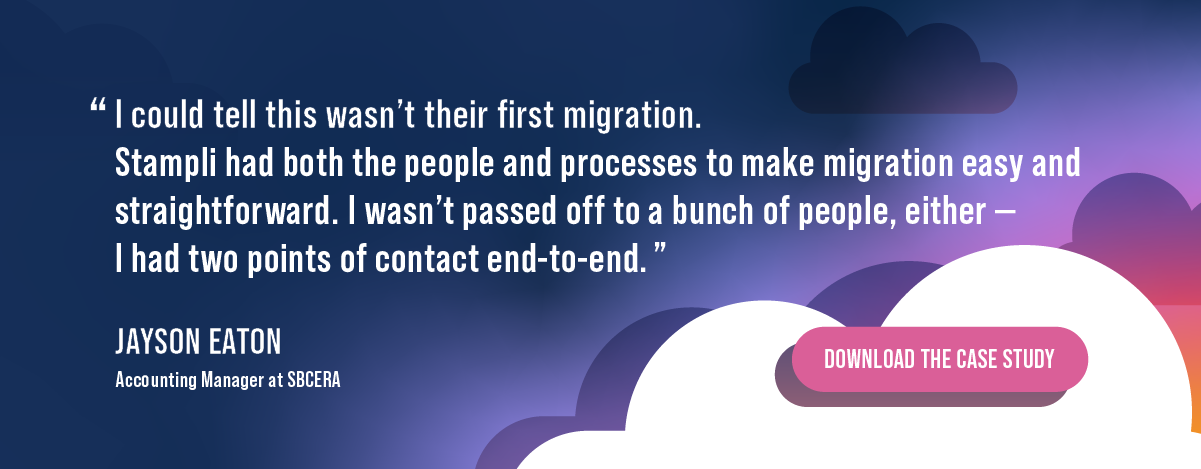
SBCERA worked with Stampli to migrate their master lists (vendors, GLs, entities, and everything else). Over the next five months, they successfully migrated their ERP to Business Central. All historical invoices, activity, audit trails, conversations, documents, and other objects processed through Stampli under the previous ERP remained and were accessible. The conversion maintained full continuity for both the AP workflow and access to historical invoices.
Migrate to a new ERP
If you want to migrate from GP but don’t want to stay in the Microsoft ecosystem, consider migrating to a new ERP system. Moving to a new ERP allows you to take advantage of real-time data visibility, better scalability, improved collaboration, and secure remote access. It also ensures continued support, product improvements, and access to new features and capabilities.
As with migrating to another Microsoft ERP, you should consider alternative solutions as part of your plans to migrate to a new ERP. While most ERP solutions provide built-in functionality for these tasks, third-party automation solutions like Stampli offer additional advantages and don’t tie you to a particular ERP.
For example, ERPs like SAP are notorious for their complex handling of purchase orders. They require AP employees to navigate multiple screens and menus to verify invoice details. AP solutions like Stampli make invoice matching simple. “My location just recently implemented SAP and we just recently started using the SAP version of Stampli,” said one user. “It’s making it much easier to reconcile Purchase Orders for payment.”
Stampli has supported numerous customer migrations from old to new ERPs and can help your business make the transition with no interruption to your business.
“Outstanding service,” says one Stampli customer. “The Stampli service team is unmatched. Our team has had any technical questions addressed by Stampli within minutes using their chat window. Also, their implementation team was with us every step of the way helping us with any specific needs for our AP processes. The software is very intuitive and allows us to manage approvals and booking seamlessly. I highly recommend this service to automate AP.”
Migrating from GP: Set a migration schedule
If you plan to migrate specific tasks or your entire finance workflow from GP to another platform, you will need to develop a migration plan and schedule. The good news is that Microsoft will support GP until at least 2028. However, you may want to migrate from the platform before then.
Your migration schedule depends on several factors. For example, you may be concerned about continued support for current and planned software integrations with GP and want to move off the platform in the near future. Alternatively, your budget may not support the migration to a new ERP immediately, so you may want to plan the migration in the medium term.
When you decide on a migration schedule, keep an eye on these factors so you aren’t caught off-guard if something changes, like an add-on provider withdrawing GP support.
Work with a migration partner for third-party integrations
After you choose a new ERP and decide on a migration schedule, begin migrating your data and integrations from Dynamics GP to your new platform. This is a crucial step because a single mistake could interrupt your business operations and affect your company’s business continuity.
Before migrating to the new ERP, ensure that your existing third-party integrations can be migrated without impacting your business. If they can’t, you may need to halt the migration until you find a way to migrate the integrations without disrupting financial operations. Stampli can help by identifying your current GP modules and add-ons and ensuring they’ll work with Stampli after your migration. In addition, Stampli works seamlessly with over 70 ERPs, so you can be assured your AP processing will be uninterrupted during and after your migration.
Stampli unlocks AP automation for GP-based businesses
Stampli’s AI and AP automation offer major productivity gains with a modern AP experience, all the while preserving GP’s functionality. With Stampli, there’s complete continuity with GP, because only Stampli provides real-time data sync and support for all GP functionality, including third-party add-ons.
Stampli is the easiest AP automation solution to integrate with GP, and when the time comes, just as easy to migrate to other ERPs like Microsoft Dynamics 365 Finance and Operations and Dynamics 365 BC. When a customer decides to migrate from one ERP to a new one, the process is carefully orchestrated to ensure a smooth transition — including migrating vendor data, matching new data sets, and maintaining business continuity.
Ranked #1 by AP users for implementation and relationship in the G2 Grid for AP Automation, Stampli is the recognized leader in effortless ERP integration. AP teams can easily configure the Stampli to accommodate specific AP processes and provide seamless data sharing – and give you one less thing to worry about when choosing to stay on Dynamics GP or migrate to BC or a new ERP.
One Stampli customer says, “Stampli has been a game changer with automating our AP process. It’s so helpful to have all invoices, comments, approvals, reporting, and more in one place that also integrates with our accounting system and is used on a daily basis. Our Stampli team, have been nothing short of supportive in getting us set up for success!”
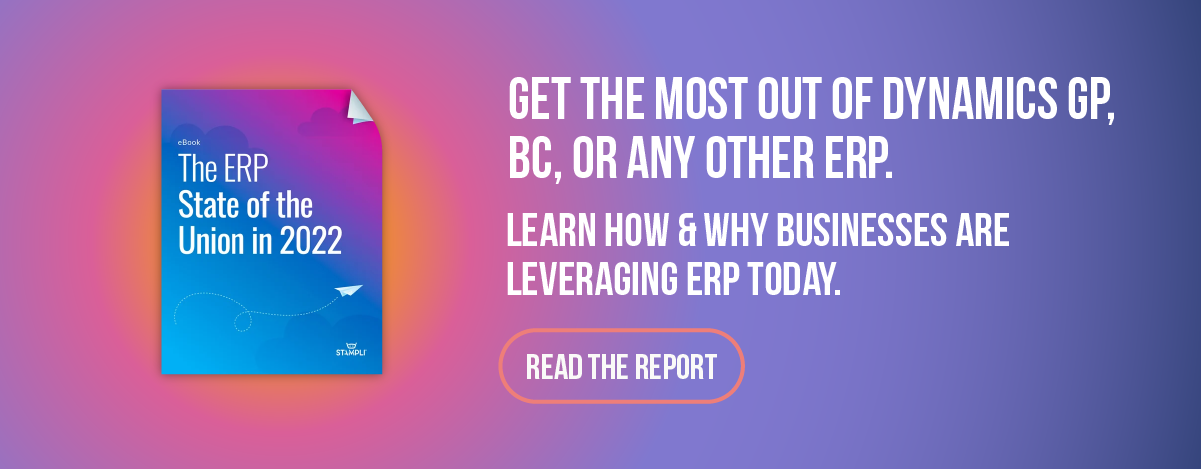
Check out Stampli’s industry-leading integration features:
Supports native functionality
Stampli’s pre-built ERP integrations support full functionality, making your AP department more efficient without having to rework your ERP or change your AP processes.
“Stampli integrates seamlessly with our construction management software making it easy to send and receive documents that need multiple approvals,” says one customer. “Once a document is signed in Stampli our construction management software is automatically notified that all parties have signed and the status is changed to approved.”
Scale with your business
Stampli’s seamless integration with Dynamics Business Central lets it adapt to current and future functionality – ensuring you can grow your business without outgrowing your AP automation.
Support for multiple ERPs, locations, subsidiaries, and currencies
Stampli offers complete flexibility to accommodate your organizational structure, no matter where you do business. It can find your existing GP add-ons and supports both the MEM add-on and intercompany transfers so you can manage multiple entities in GP via a single Stampli account.
Flexible cloud-based AP platform
Implement Stampli and integrate it with GP or any other ERP without additional hardware, and access your AP workflows and data from any device, anywhere, anytime.If you’re an existing Dynamics GP customer, and you’d like to discuss your options for integrating accounts payable automation with GP or migrating from GP to a new ERP, we can help. Contact Stampli today to talk to one of our experts.


